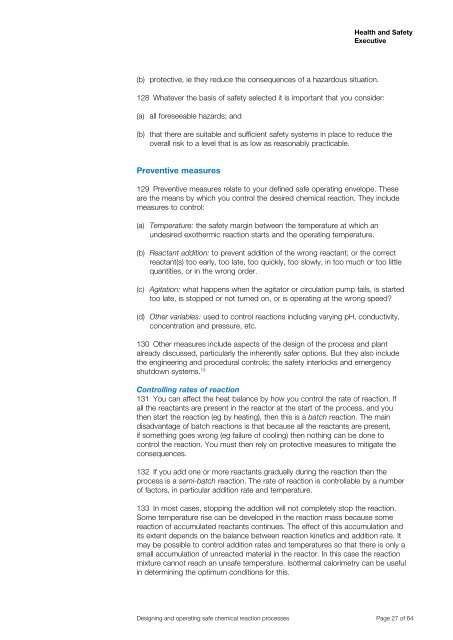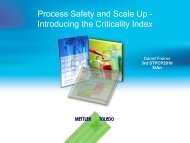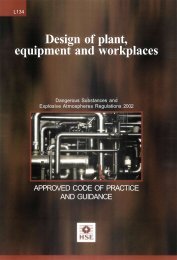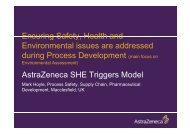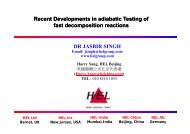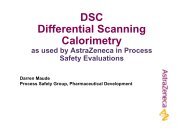Designing and operating safe chemical reaction processes HSG143
Designing and operating safe chemical reaction processes HSG143
Designing and operating safe chemical reaction processes HSG143
Create successful ePaper yourself
Turn your PDF publications into a flip-book with our unique Google optimized e-Paper software.
Health <strong>and</strong> SafetyExecutive(b) protective, ie they reduce the consequences of a hazardous situation.128 Whatever the basis of <strong>safe</strong>ty selected it is important that you consider:(a) all foreseeable hazards; <strong>and</strong>(b) that there are suitable <strong>and</strong> sufficient <strong>safe</strong>ty systems in place to reduce theoverall risk to a level that is as low as reasonably practicable.Preventive measures129 Preventive measures relate to your defined <strong>safe</strong> <strong>operating</strong> envelope. Theseare the means by which you control the desired <strong>chemical</strong> <strong>reaction</strong>. They includemeasures to control:(a) Temperature: the <strong>safe</strong>ty margin between the temperature at which anundesired exothermic <strong>reaction</strong> starts <strong>and</strong> the <strong>operating</strong> temperature.(b) Reactant addition: to prevent addition of the wrong reactant; or the correctreactant(s) too early, too late, too quickly, too slowly, in too much or too littlequantities, or in the wrong order.(c) Agitation: what happens when the agitator or circulation pump fails, is startedtoo late, is stopped or not turned on, or is <strong>operating</strong> at the wrong speed?(d) Other variables: used to control <strong>reaction</strong>s including varying pH, conductivity,concentration <strong>and</strong> pressure, etc.130 Other measures include aspects of the design of the process <strong>and</strong> plantalready discussed, particularly the inherently <strong>safe</strong>r options. But they also includethe engineering <strong>and</strong> procedural controls; the <strong>safe</strong>ty interlocks <strong>and</strong> emergencyshutdown systems. 15Controlling rates of <strong>reaction</strong>131 You can affect the heat balance by how you control the rate of <strong>reaction</strong>. Ifall the reactants are present in the reactor at the start of the process, <strong>and</strong> youthen start the <strong>reaction</strong> (eg by heating), then this is a batch <strong>reaction</strong>. The maindisadvantage of batch <strong>reaction</strong>s is that because all the reactants are present,if something goes wrong (eg failure of cooling) then nothing can be done tocontrol the <strong>reaction</strong>. You must then rely on protective measures to mitigate theconsequences.132 If you add one or more reactants gradually during the <strong>reaction</strong> then theprocess is a semi-batch <strong>reaction</strong>. The rate of <strong>reaction</strong> is controllable by a numberof factors, in particular addition rate <strong>and</strong> temperature.133 In most cases, stopping the addition will not completely stop the <strong>reaction</strong>.Some temperature rise can be developed in the <strong>reaction</strong> mass because some<strong>reaction</strong> of accumulated reactants continues. The effect of this accumulation <strong>and</strong>its extent depends on the balance between <strong>reaction</strong> kinetics <strong>and</strong> addition rate. Itmay be possible to control addition rates <strong>and</strong> temperatures so that there is only asmall accumulation of unreacted material in the reactor. In this case the <strong>reaction</strong>mixture cannot reach an un<strong>safe</strong> temperature. Isothermal calorimetry can be usefulin determining the optimum conditions for this.<strong>Designing</strong> <strong>and</strong> <strong>operating</strong> <strong>safe</strong> <strong>chemical</strong> <strong>reaction</strong> <strong>processes</strong> Page 27 of 64


